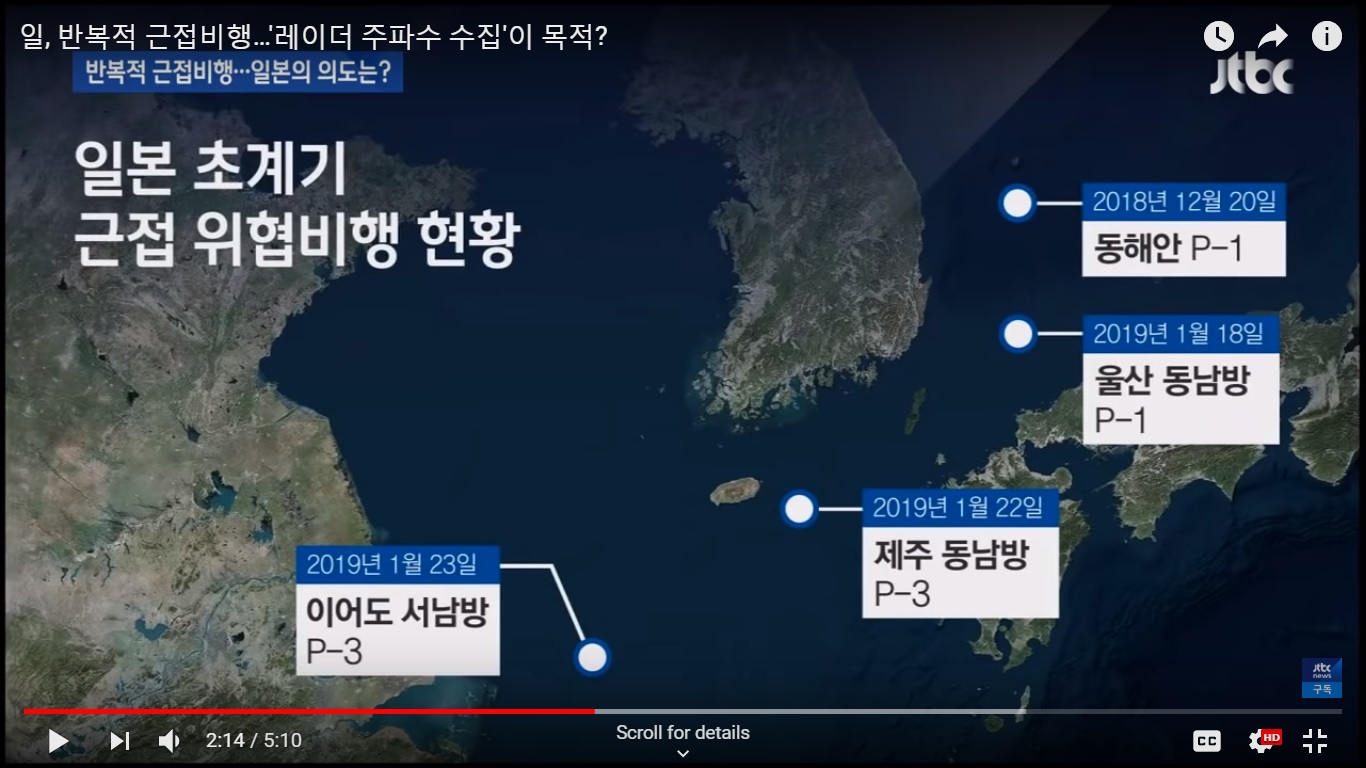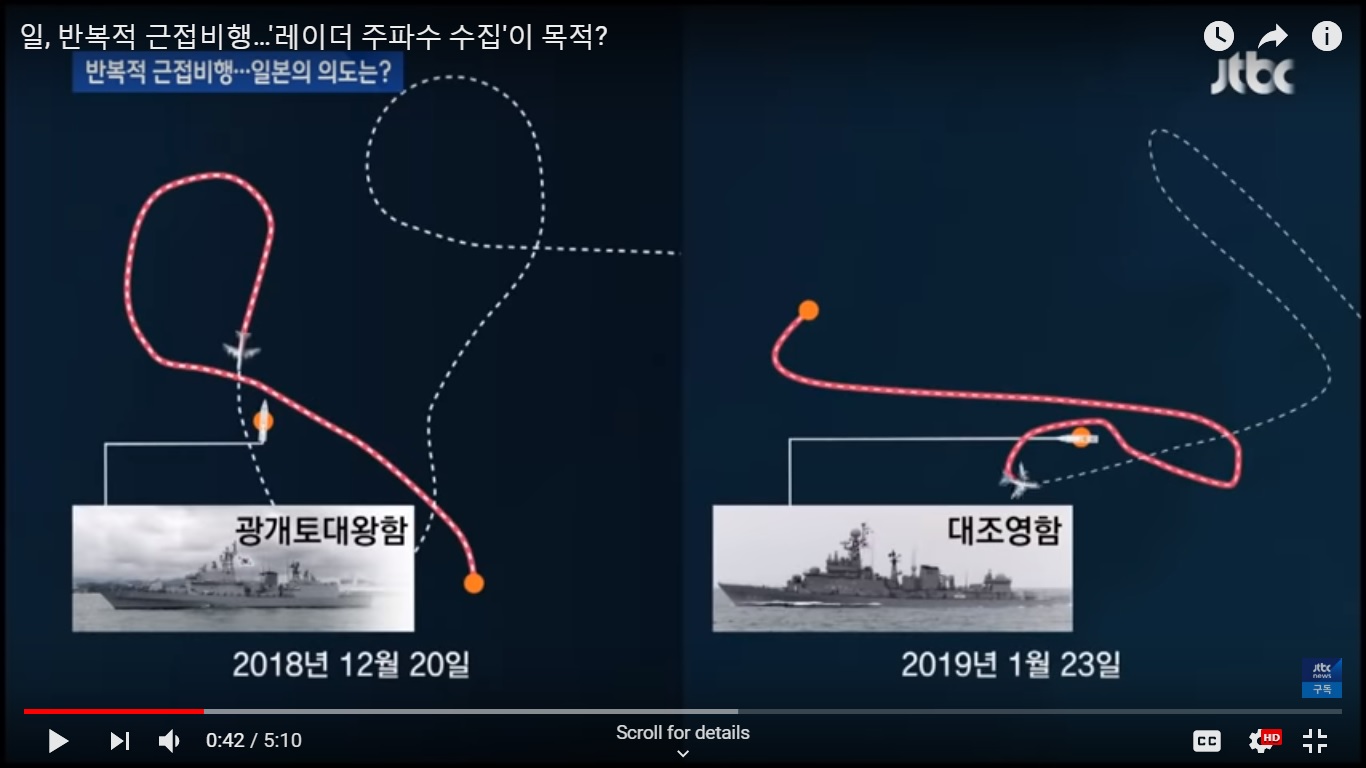Welcome to DU!
The truly grassroots left-of-center political community where regular people, not algorithms, drive the discussions and set the standards.
Join the community:
Create a free account
Support DU (and get rid of ads!):
Become a Star Member
Latest Breaking News
Editorials & Other Articles
General Discussion
The DU Lounge
All Forums
Issue Forums
Culture Forums
Alliance Forums
Region Forums
Support Forums
Help & Search
Japanese Maritime Patrol Incidents- Part II

(Source - JTBC News 01.23.19) Repeated Japanese reconnaisance approaches- is radar emission collection the objective? What are Japan's intentions? Situation of dangerous approaches by Japanese patrol aircraft.
JTBC news reporting, January 23, stated that the Japanese patrol aircraft in the incidents on January 22, and 23 were P-3s rather than P-1s. This report describes the last incident on the 23rd as occurring 131 km south of Socotra rocks. The incident the day before was 96 km south of Cheju Island, and a third incident was southeast of Eulsan in the East Sea. The initial incident on December 20 is shown in the Sea of Japan/ East Sea in the region of Dokto or Liancourt Rocks.

(Source - JTBC News 01.23.19) Graphics display the relative movements of Japanese maritime patrol aircraft and the South Korean naval vessels being approached on December 20 and January 23, respectively.

(Source - JTBC News 01.23.19) This graphic adds a depiction of the closest approaches in distance to the South Korean vessels with altitude, all in meters.
This JTBC report says the military related sources they contacted in connection with the story said this is definitely an intelligence collection effort by the Japanese. There is no need to close to such a short range from the surveillance target. Sufficient identifying information could be obtained from much further away. One maritime patrol pilot said the Japanese video from the P-1 in the December 20 incident showed its low altitude flight approach interfering in the rescue effort by the South Korean naval ship working to save a North Korean fishing crew from a disabled vessel.
In the subsequent January incidents of irregular and hazardous approaches, it appears the Japanese may have been trying to collect the radar frequencies that they couldn't produce at the talks they walked out on January 21 concerning the dispute over the December 20 encounter. The South Korean side said the Japanese hadn't provided the technical electronic evidence to support their contentions about the December 20 incident. This suggests that if the objective of the Japanese is not simply a political one of demonstrating dissatisfaction with their relationship with South Korea, they were trying to get the South Korean naval vessels to light up the fire control radars. Hankyoreh reported that the Japanese didn't even bring a radar expert with them to the talks that ended in stalemate on the 21st:
Tokyo appears to have determined it lacks the evidence to refute Seoul’s position.
http://english.hani.co.kr/arti/english_edition/e_international/879415.html
Coincidentally, the Japanese have borrowed the expression "Korexit" in the attempt by the former colonial ruler of Korea to gain more control over the policies of the "left leaning" democracy of South Korea:
Beijing could gain and Washington lose if feuding persists between U.S. allies Japan and South Korea, a foreign policy adviser to Japan’s premier said on Thursday after the latest row involving a Japanese patrol plane and South Korean warship.
https://af.reuters.com/article/worldNews/idAFKCN1PI0HD
One JTBC reporter who covered the Korean Ministry of Defense statement on the encounters at sea with Japanese aircraft, was asked what is the next step in taking appropriate measures in event of further menacing flight maneuvers by Japanese maritime patrol aircraft. He replied that if an aircraft engaging in provocative maneuvers is unresponsive to communications from the South Korean navy, that after an appropriate warning from the surface vessel to the Japanese aircraft, warning shots could be fired.